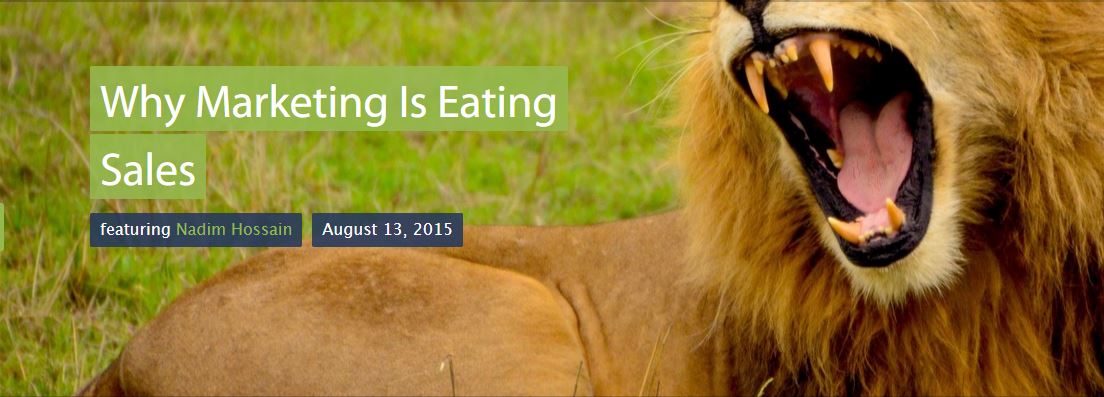Why Marketing is Eating Sales
GREAT ARTICLE by Nadim Hossain on “Why Marketing is Eating Sales”: Link
We live in a mobile-first world where mobility references the mobility of the user, not the device. As a result, users are driving cloud-connected solutions to enable their mobile lifestyles. This connected society has generated a social-first approach to communication, and as a result all marketing must have a social-first and mobile-first strategy in order to remain relevant.
In the article “Why Marketing is Eating Sales”, Nadim argues that:
As adoption of technology and automation continues to expand, Marketing will become an even more dominant part of the buyer journey. In fact, as buyers grow accustomed to getting personalized information on-demand without the help of a human sales rep, they’ll demand more of those types of hyper-relevant automated experiences, and much less human interaction. (After all, none of us long for the days of human toll collectors on the Golden Gate Bridge, do we?).
The Modern CMO is a Revenue Marketer, in command of the entire customer experience from Anonymous to Usage. To be successful, the Modern CMO needs to be a three-headed Hydra – Creative; Analytical; and User Experience oriented – because the job of the Modern CMO is really the job of Customer Life Cycle (CLC) management. Specifically, the CLC process begins with reactive and proactive social engagement with Unknown Visitors; continues with nurture activities with Known Prospects; converts those Known Prospects into Marketing Automation Qualified Leads (MAQLs) by reading the Digital Body Language of prospects; and then tracks the performance of those MAQLs into Sales Accepted Leads (SALs) and Sales Qualified Leads (SQLs). However, into today’s consumption- and cloud-focused world, the real selling process begins after the first transaction, so the Modern CMO must have the ability to activate customer usage (not just generate a first purchase), which requires product innovation and understanding.
Nadim makes a convincing point that three key drivers that will continue to influence Marketing’s rise up the food chain:
- The evolution of the Internet and mobile. It’s easy to overlook how much has changed in just 10 years. In 2005, the world hit a milestone with 1 billion Internet users. Ten years later, that number has tripled to more than 3 billion. And by 2020, that number is expected to exceed 4 billion. But even those numbers underestimate the pervasiveness of the web. Thanks to the explosion of mobile (and, in the future,wearables), people are always online. This changes how Sales and Marketing operate in very fundamental ways.
- More channels = More complex buyer’s journey. As I mentioned above, the modern buyer’s journey — whether it’s for a consumer or business product — traverses a complex path through multiple channels and platforms en route to a sale. Whether it’s social media, email, user reviews, or the good old-fashioned telephone, there are countless ways to connect with customers (and them to us). This has turned Marketing into a bi-directional, social operation that requires the constant delivery of highly personal — and contextually relevant — campaigns.
- The adaptation of human behavior. In tandem with our connectedness and the complex nature of the modern buyer’s journey, human behavior is changing, as well. For proof of that, just look at millennials — a group that comprises one-fourth of the U.S. population and boasts $200B in buying power. In this generation, word of mouth, authentic user reviews, and social media play an increasingly important part in driving sales. According to one study, 91 percent of millennials say they’d consider buying a product if a friend recommended it. This trend is another big win for Marketing, which has long been responsible for brand awareness and customer advocacy.
I’d encourage you to read the whole article, which does a nice job of summarizing the revolutionary nature of today’s marketing industry — the most exciting time to be in marketing since the invention of mass marketing.

